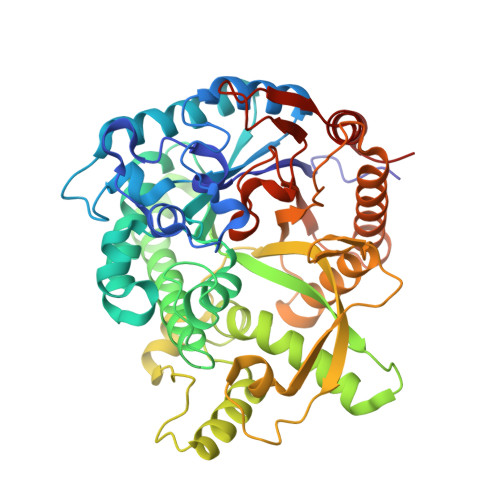Klotho-related protein is a novel cytosolic neutral beta-glycosylceramidase.
Hayashi, Y., Okino, N., Kakuta, Y., Shikanai, T., Tani, M., Narimatsu, H., Ito, M.(2007) J Biol Chem 282: 30889-30900
- PubMed: 17595169
- DOI: https://doi.org/10.1074/jbc.M700832200
- Primary Citation of Related Structures:
2E9L, 2E9M - PubMed Abstract:
Using C6-NBD-glucosylceramide (GlcCer) as a substrate, we detected the activity of a conduritol B epoxide-insensitive neutral glycosylceramidase in cytosolic fractions of zebrafish embryos, mouse and rat brains, and human fibroblasts. The candidates for the enzyme were assigned to the Klotho (KL), whose family members share a beta-glucosidase-like domain but whose natural substrates are unknown. Among this family, only the KL-related protein (KLrP) is capable of degrading C6-NBD-GlcCer when expressed in CHOP cells, in which Myc-tagged KLrP was exclusively distributed in the cytosol. In addition, knockdown of the endogenous KLrP by small interfering RNA increased the cellular level of GlcCer. The purified recombinant KLrP hydrolyzed 4-methylumbelliferyl-glucose, C6-NBD-GlcCer, and authentic GlcCer at pH 6.0. The enzyme also hydrolyzed the corresponding galactosyl derivatives, but each k(cat)/Km was much lower than that for glucosyl derivatives. The x-ray structure of KLrP at 1.6A resolution revealed that KLrP is a (beta/alpha)8 TIM barrel, in which Glu(165) and Glu(373) at the carboxyl termini of beta-strands 4 and 7 could function as an acid/base catalyst and nucleophile, respectively. The substrate-binding cleft of the enzyme was occupied with palmitic acid and oleic acid when the recombinant protein was crystallized in a complex with glucose. GlcCer was found to fit well the cleft of the crystal structure of KLrP. Collectively, KLrP was identified as a cytosolic neutral glycosylceramidase that could be involved in a novel nonlysosomal catabolic pathway of GlcCer.
Organizational Affiliation:
Department of Bioscience and Biotechnology, Graduate School of Bioresource and Bioenvironmental Sciences, Kyushu University, 6-10-1 Hakozaki, Fukuoka 812-8581, Japan.

















